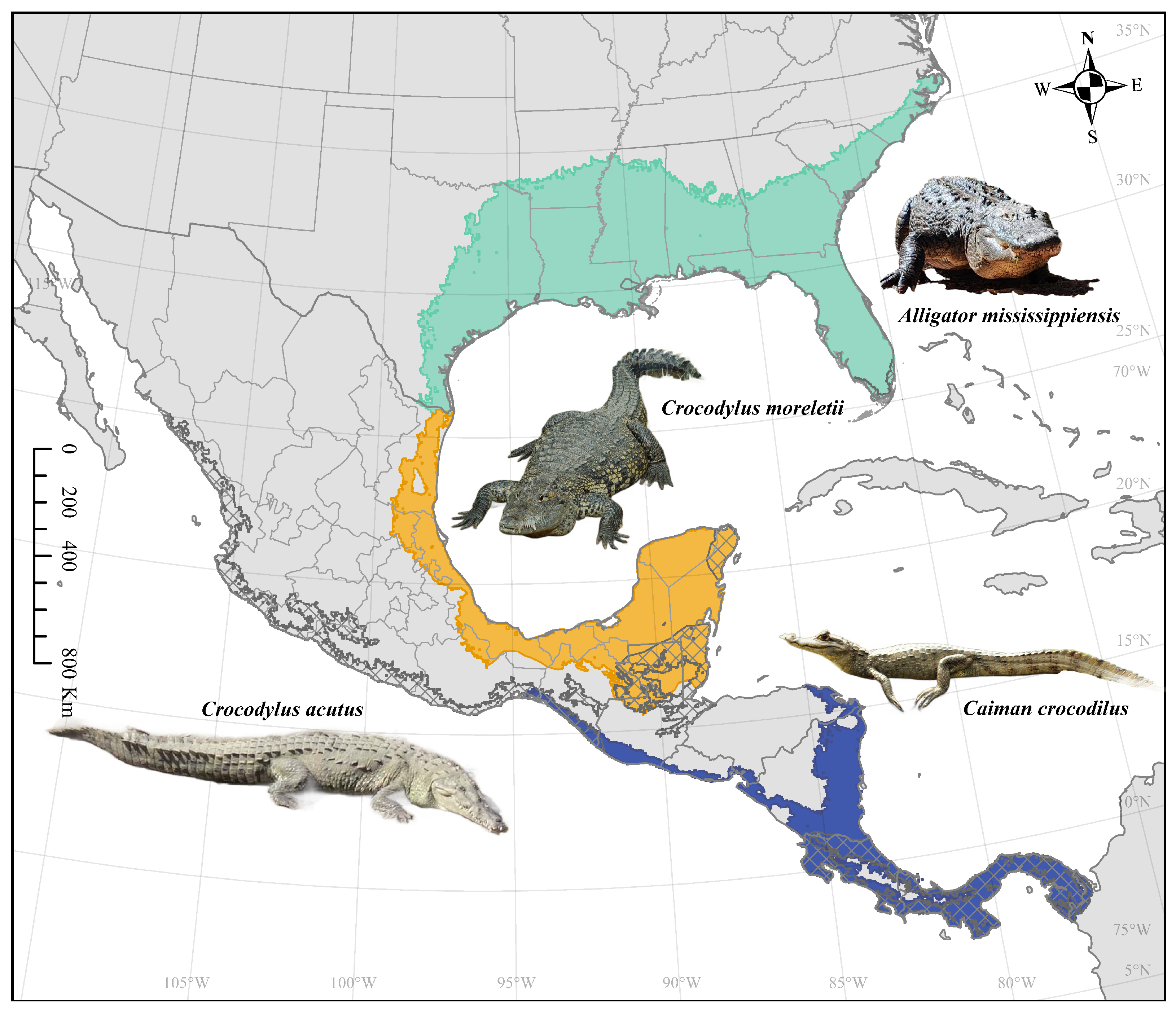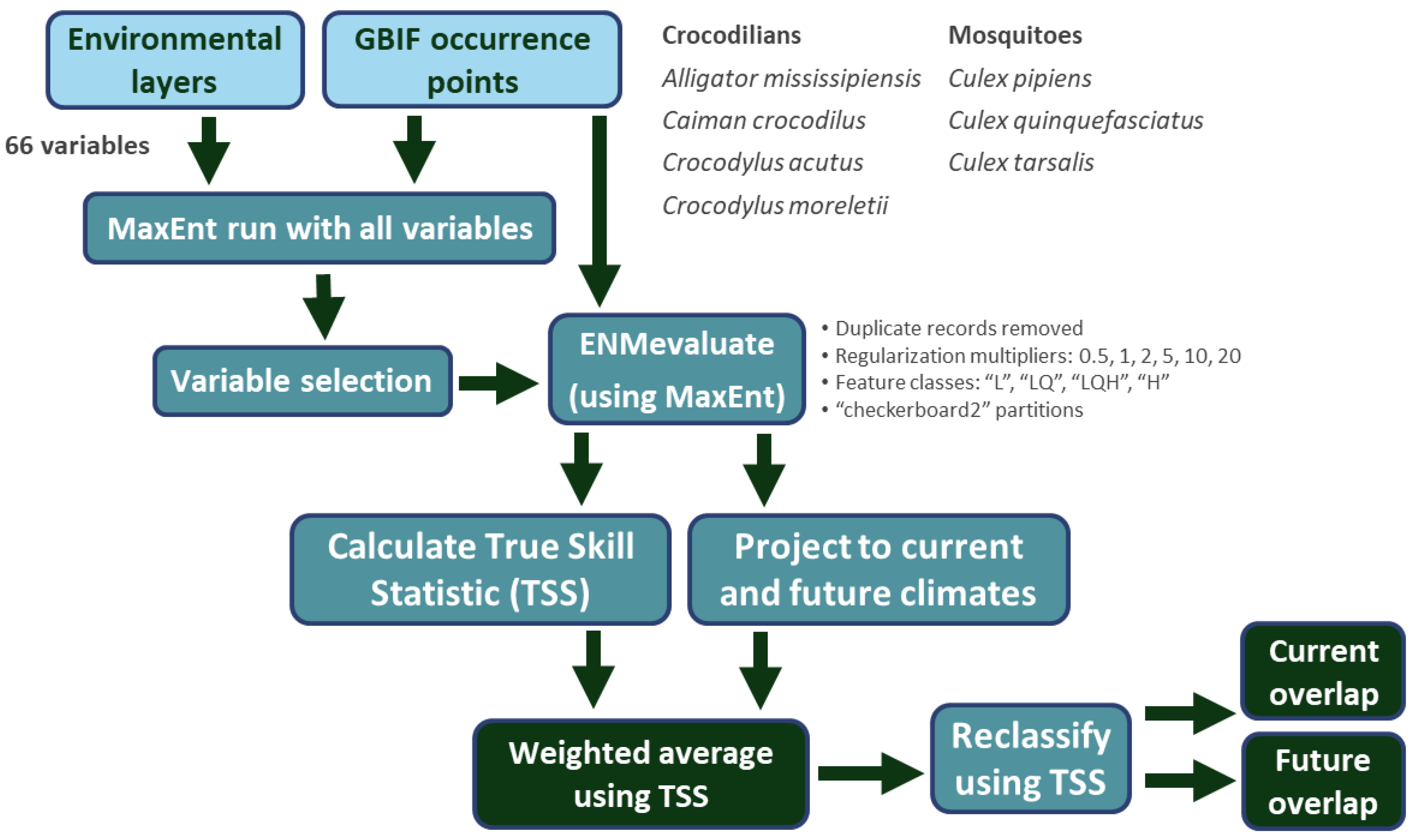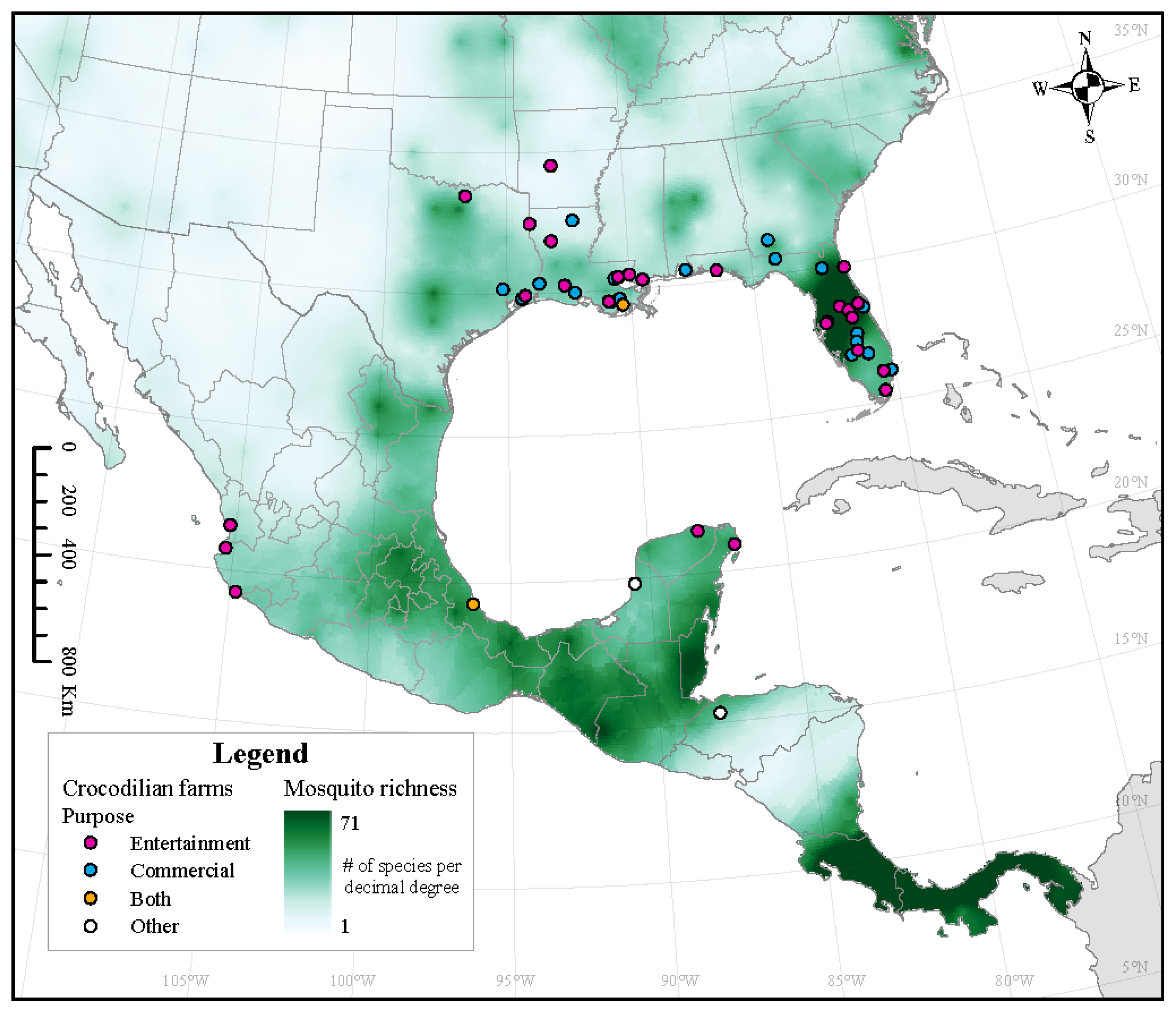The Alligator and the Mosquito: North American Crocodilians as Amplifiers of West Nile Virus in Changing Climates
Abstract
:1. Introduction
2. Materials and Methods
3. Results
3.1. Model Fit Statistics
3.2. Variable Contribution
3.3. Area and Overlap Statistics
4. Discussion
4.1. Species-Specific Distribution Changes
4.2. Crocodilian Risk Profiles
4.3. Conservation and Public Health Implications
4.4. Avian Influence
4.5. Other Considerations
5. Conclusions
Supplementary Materials
Author Contributions
Funding
Data Availability Statement
Acknowledgments
Conflicts of Interest
References
- Li, R.; Xu, L.; Bjornstad, O.; Liu, K.; Song, T.; Chen, A.; Xu, B.; Liu, Q.; Stenseth, N. Climate-Driven Variation in Mosquito Density Predicts the Spatiotemporal Dynamics of Dengue. Proc. Natl. Acad. Sci. USA 2019, 116, 3624–3629. [Google Scholar] [CrossRef] [PubMed]
- Eder, M.; Cortes, F.; Teixeira de Siqueira Filha, N.; Araújo de França, G.V.; Degroote, S.; Braga, C.; Ridde, V.; Turchi Martelli, C.M. Scoping Review on Vector-Borne Diseases in Urban Areas: Transmission Dynamics, Vectorial Capacity and Co-Infection. Infect. Dis. Poverty 2018, 7, 90. [Google Scholar] [CrossRef] [PubMed]
- Ozdenerol, E.; Taff, G.N.; Akkus, C. Exploring the Spatio-Temporal Dynamics of Reservoir Hosts, Vectors, and Human Hosts of West Nile Virus: A Review of the Recent Literature. Int. J. Environ. Res. Public Health 2013, 10, 5399–5432. [Google Scholar] [CrossRef]
- Godsey, M.S.; Burkhalter, K.; Young, G.; Delorey, M.; Smith, K.; Townsend, J.; Levy, C.; Mutebi, J.-P. Entomologic Investigations during an Outbreak of West Nile Virus Disease in Maricopa County, Arizona, 2010. Am. J. Trop. Med. Hyg. 2012, 87, 1125–1131. [Google Scholar] [CrossRef] [PubMed]
- Mordecai, E.A.; Caldwell, J.M.; Grossman, M.K.; Lippi, C.A.; Johnson, L.R.; Neira, M.; Rohr, J.R.; Ryan, S.J.; Savage, V.; Shocket, M.S.; et al. Thermal Biology of Mosquito-Borne Disease. Ecol. Lett. 2019, 22, 1690–1708. [Google Scholar] [CrossRef] [PubMed]
- Ruybal, J.E.; Kramer, L.D.; Kilpatrick, A.M. Geographic Variation in the Response of Culex Pipiens Life History Traits to Temperature. Parasites Vectors 2016, 9, 116. [Google Scholar] [CrossRef]
- Andriamifidy, R.F.; Tjaden, N.B.; Beierkuhnlein, C.; Thomas, S.M. Do We Know How Mosquito Disease Vectors Will Respond to Climate Change? Emerg. Top. Life Sci. 2019, 3, 115–132. [Google Scholar] [CrossRef]
- Nash, D.; Mostashari, F.; Fine, A.; Miller, J.; O’Leary, D.; Murray, K.; Huang, A.; Rosenberg, A.; Greenberg, A.; Sherman, M.; et al. The Outbreak of West Nile Virus Infection in the New York City Area in 1999. N. Engl. J. Med. 2001, 344, 1807–1814. [Google Scholar] [CrossRef]
- Petersen, L.R.; Marfin, A.A.; Gubler, D.J. West Nile Virus. JAMA 2003, 290, 524–528. [Google Scholar] [CrossRef]
- Turell, M.J.; Dohm, D.J.; Sardelis, M.R.; O’guinn, M.L.; Andreadis, T.G.; Blow, J.A. An Update on the Potential of North American Mosquitoes (Diptera: Culicidae) to Transmit West Nile Virus. J. Med. Entomol. 2005, 42, 57–62. [Google Scholar] [CrossRef]
- Campbell, G.L.; Marfin, A.A.; Lanciotti, R.S.; Gubler, D.J. West Nile Virus. Lancet Infect. Dis. 2002, 2, 519–529. [Google Scholar] [CrossRef] [PubMed]
- Komar, N. West Nile Viral Encephalitis. Rev. Sci. Et Tech.-Off. Int. Des Epizoot. 2000, 19, 166–176. [Google Scholar] [CrossRef] [PubMed]
- Hayes, E.B.; Komar, N.; Nasci, R.S.; Montgomery, S.P.; O’Leary, D.R.; Campbell, G.L. Epidemiology and Transmission Dynamics of West Nile Virus Disease. Emerg. Infect. Dis. 2005, 11, 1167–1173. [Google Scholar] [CrossRef] [PubMed]
- McDonald, E.; Mathis, S.; Martin, S.W.; Erin Staples, J.; Fischer, M.; Lindsey, N.P. Surveillance for West Nile Virus Disease—United States, 2009–2018. Am. J. Transplant. 2021, 21, 1959–1974. [Google Scholar] [CrossRef] [PubMed]
- Kilpatrick, A.M.; LaDeau, S.L.; Marra, P.P. Ecology of West Nile Virus Transmission and Its Impact on Birds in the Western Hemisphere. Auk 2007, 124, 1121–1136. [Google Scholar] [CrossRef]
- Reisen, W.K.; Barker, C.M.; Carney, R.; Lothrop, H.D.; Wheeler, S.S.; Wilson, J.L.; Madon, M.B.; Takahashi, R.; Carroll, B.; Garcia, S.; et al. Role of Corvids in Epidemiology of West Nile Virus in Southern California. J. Med. Entomol. 2006, 43, 356–367. [Google Scholar] [CrossRef]
- Dauphin, G.; Zientara, S.; Zeller, H.; Murgue, B. West Nile: Worldwide Current Situation in Animals and Humans. Comp. Immunol. Microbiol. Infect. Dis. 2004, 27, 343–355. [Google Scholar] [CrossRef]
- Solomon, T.; Vaughn, D.W. Pathogenesis and Clinical Features of Japanese Encephalitis and West Nile Virus Infections. In Japanese Encephalitis and West Nile Viruses; Mackenzie, J.S., Barrett, A.D.T., Deubel, V., Eds.; Current Topics in Microbiology and Immunology; Springer: Berlin/Heidelberg, Germany, 2002; Volume 267, pp. 171–194. ISBN 978-3-642-63966-1. [Google Scholar]
- Watson, J.T.; Gerber, S.I. West Nile Virus: A Brief Review. Pediatr. Infect. Dis. J. 2004, 23, 357. [Google Scholar] [CrossRef]
- Hayes, E.B.; Sejvar, J.J.; Zaki, S.R.; Lanciotti, R.S.; Bode, A.V.; Campbell, G.L. Virology, Pathology, and Clinical Manifestations of West Nile Virus Disease. Emerg. Infect. Dis. 2005, 11, 1174–1179. [Google Scholar] [CrossRef]
- Hughes, J.M.; Wilson, M.E.; Sejvar, J.J. The Long-Term Outcomes of Human West Nile Virus Infection. Clin. Infect. Dis. 2007, 44, 1617–1624. [Google Scholar] [CrossRef]
- Saalfeld, D.T.; Webb, K.K.; Conway, W.C.; Calkins, G.E.; Duguay, J.P. Growth and Condition of American Alligators (Alligator mississippiensis) in an Inland Wetland of East Texas. Southeast. Nat. 2008, 7, 541–550. [Google Scholar] [CrossRef]
- Wood, J.M.; Woodward, A.R.; Humphrey, S.R.; Hines, T.C. Night Counts as an Index of American Alligator Population Trends. Wildl. Soc. Bull. (1973–2006) 1985, 13, 262–273. [Google Scholar]
- Nickum, M.J.; Masser, M.; Reigh, R.; Nickum, J.G. Alligator (Alligator mississippiensis) Aquaculture in the United States. Rev. Fish. Sci. Aquac. 2018, 26, 86–98. [Google Scholar] [CrossRef]
- Masser, M.P. Alligator Production: Breeding and Egg Incubation; Southern Regional Aquaculture Center (SRAC): Stoneville, MS, USA, 1993; No. 231; 7p. [Google Scholar]
- Moyle, B. Conservation That’s More than Skin-Deep: Alligator Farming. Biodivers. Conserv. 2013, 22, 1663–1677. [Google Scholar] [CrossRef]
- Byas, A.D.; Gallichotte, E.N.; Hartwig, A.E.; Porter, S.M.; Gordy, P.W.; Felix, T.A.; Bowen, R.A.; Ebel, G.D.; Bosco-Lauth, A.M. American Alligators Are Capable of West Nile Virus Amplification, Mosquito Infection and Transmission. Virology 2022, 568, 49–55. [Google Scholar] [CrossRef]
- Klenk, K.; Snow, J.; Morgan, K.; Bowen, R.; Stephens, M.; Foster, F.; Gordy, P.; Beckett, S.; Komar, N.; Gubler, D.; et al. Alligators as West Nile Virus Amplifiers. Emerg. Infect. Dis. 2004, 10, 2150–2155. [Google Scholar] [CrossRef]
- Nevarez, J.G.; Mitchell, M.A.; Morgan, T.; Roy, A.; Johnson, A. Association of West Nile Virus with Lymphohistiocytic Proliferative Cutaneous Lesions in American Alligators (Alligator mississippiensis) Detected by RT-PCR. J. Zoo Wildl. Med. 2008, 39, 562–566. [Google Scholar] [CrossRef]
- Isberg, S.; Moran, J.; De Araujo, R.; Elliott, N.; Davis, S.; Melville, L. First Evidence of Kunjin Strain of West Nile Virus Associated with Saltwater Crocodile (Crocodylus porosus) Skin Lesions. Aust. Vet. J. 2019, 97, 390–393. [Google Scholar] [CrossRef]
- Habarugira, G.; Moran, J.; Colmant, A.M.G.; Davis, S.S.; O’Brien, C.A.; Hall-Mendelin, S.; McMahon, J.; Hewitson, G.; Nair, N.; Barcelon, J.; et al. Mosquito-Independent Transmission of West Nile Virus in Farmed Saltwater Crocodiles (Crocodylus porosus). Viruses 2020, 12, 198. [Google Scholar] [CrossRef]
- GBIF.org. GBIF Occurrence Download. 2024. Available online: https://doi.org/10.15468/dl.kh4pas (accessed on 3 June 2024).
- GBIF.org. GBIF Occurrence Download. 2023. Available online: https://doi.org/10.15468/dl.j5k6d2 (accessed on 21 September 2023).
- Fick, S.E.; Hijmans, R.J. WorldClim 2: New 1-km Spatial Resolution Climate Surfaces for Global Land Areas. Int. J. Climatol. 2017, 37, 4302–4315. [Google Scholar] [CrossRef]
- Phillips, S.J.; Anderson, R.P.; Dudík, M.; Schapire, R.E.; Blair, M.E. Opening the black box: An open-source release of Maxent. Ecography 2017, 40, 887–893. [Google Scholar] [CrossRef]
- Hijmans, R.J.; Phillips, S.; Leathwick, J.; Elith, J.; Hijmans, M.R.J. Package ‘Dismo’. Circles 2017, 9, 1–68. [Google Scholar]
- Kass, J.M.; Muscarella, R.; Galante, P.J.; Bohl, C.L.; Pinilla-Buitrago, G.E.; Boria, R.A.; Soley-Guardia, M.; Anderson, R.P. ENMeval 2.0: Redesigned for Customizable and Reproducible Modeling of Species’ Niches and Distributions. Methods Ecol. Evol. 2021, 12, 1602–1608. [Google Scholar] [CrossRef]
- Allouche, O.; Tsoar, A.; Kadmon, R. Assessing the Accuracy of Species Distribution Models: Prevalence, Kappa and the True Skill Statistic (TSS). J. Appl. Ecol. 2006, 43, 1223–1232. [Google Scholar] [CrossRef]
- Riahi, K.; van Vuuren, D.P.; Kriegler, E.; Edmonds, J.; O’Neill, B.C.; Fujimori, S.; Bauer, N.; Calvin, K.; Dellink, R.; Fricko, O.; et al. The Shared Socioeconomic Pathways and Their Energy, Land Use, and Greenhouse Gas Emissions Implications: An Overview. Glob. Environ. Chang. 2017, 42, 153–168. [Google Scholar] [CrossRef]
- Tatebe, H.; Ogura, T.; Nitta, T.; Komuro, Y.; Ogochi, K.; Takemura, T.; Sudo, K.; Sekiguchi, M.; Abe, M.; Saito, F.; et al. Description and Basic Evaluation of Simulated Mean State, Internal Variability, and Climate Sensitivity in MIROC6. Geosci. Model Dev. 2019, 12, 2727–2765. [Google Scholar] [CrossRef]
- Voldoire, A.; Saint-Martin, D.; Sénési, S.; Decharme, B.; Alias, A.; Chevallier, M.; Colin, J.; Guérémy, J.-F.; Michou, M.; Moine, M.-P.; et al. Evaluation of CMIP6 DECK Experiments with CNRM-CM6-1. J. Adv. Model. Earth Syst. 2019, 11, 2177–2213. [Google Scholar] [CrossRef]
- Lobo, J.M.; Jiménez-Valverde, A.; Real, R. AUC: A Misleading Measure of the Performance of Predictive Distribution Models. Glob. Ecol. Biogeogr. 2008, 17, 145–151. [Google Scholar] [CrossRef]
- Chaves, L.F.; Hamer, G.L.; Walker, E.D.; Brown, W.M.; Ruiz, M.O.; Kitron, U.D. Climatic Variability and Landscape Heterogeneity Impact Urban Mosquito Diversity and Vector Abundance and Infection. Ecosphere 2011, 2, art70. [Google Scholar] [CrossRef]
- Gorris, M.E.; Bartlow, A.W.; Pitts, T.; Manore, C.A. Projections of Aedes and Culex Mosquitoes across North and South America in Response to Climate Change. J. Clim. Chang. Health 2024, 17, 100317. [Google Scholar] [CrossRef]
- Woodward, A.R.; Percival, H.F.; Rauschenberger, R.H.; Gross, T.S.; Rice, K.G.; Conrow, R. Abnormal Alligators and Organochlorine Pesticides in Lake Apopka, Florida. In Wildlife Ecotoxicology: Forensic Approaches; Elliott, J.E., Bishop, C.A., Morrissey, C.A., Eds.; Springer: New York, NY, USA, 2011; pp. 153–187. ISBN 978-0-387-89432-4. [Google Scholar]
- Rainwater, T.R.; Adair, B.M.; Platt, S.G.; Anderson, T.A.; Cobb, G.P.; McMurry, S.T. Mercury in Morelet’s Crocodile Eggs from Northern Belize. Arch. Environ. Contam. Toxicol. 2002, 42, 319–324. [Google Scholar] [CrossRef]
- Mazzotti, F.J.; Best, G.R.; Brandt, L.A.; Cherkiss, M.S.; Jeffery, B.M.; Rice, K.G. Alligators and Crocodiles as Indicators for Restoration of Everglades Ecosystems. Ecol. Indic. 2009, 9, S137–S149. [Google Scholar] [CrossRef]
- Medley, C. One Way to Halt Poaching—Gator Farming. New York Times, 18 January 1970. [Google Scholar]
- Yang, L.; Turo, K.J.; Riley, C.B.; Inocente, E.A.; Tian, J.; Hoekstra, N.C.; Piermarini, P.M.; Gardiner, M.M. Can Urban Greening Increase Vector Abundance in Cities? The Impact of Mowing, Local Vegetation, and Landscape Composition on Adult Mosquito Populations. Urban. Ecosyst. 2019, 22, 827–839. [Google Scholar] [CrossRef]
- Gleiser, R.M.; Zalazar, L.P. Distribution of Mosquitoes in Relation to Urban Landscape Characteristics. Bull. Entomol. Res. 2010, 100, 153–158. [Google Scholar] [CrossRef] [PubMed]
- Buckner, E.; Blackmore, M.; Golladay, S.; Covich, A. Weather and Landscape Factors Associated with Adult Mosquito Abundance in Southwestern Georgia, USA. J. Vector Ecol. 2011, 36, 269–278. [Google Scholar] [CrossRef] [PubMed]
- Gardner, A.; Hamer, G.; Hines, A.; Newman, C.; Walker, E.; Ruiz, M. Weather Variability Affects Abundance of Larval Culex (Diptera: Culicidae) in Storm Water Catch Basins in Suburban Chicago. J. Med. Entomol. 2012, 49, 270–276. [Google Scholar] [CrossRef]
- Benson, T.J.; Ward, M.P.; Lampman, R.L.; Raim, A.; Weatherhead, P.J. Implications of Spatial Patterns of Roosting and Movements of American Robins for West Nile Virus Transmission. Vector-Borne Zoonotic Dis. 2012, 12, 877–885. [Google Scholar] [CrossRef]
- Levine, R.S.; Mead, D.G.; Hamer, G.L.; Brosi, B.J.; Hedeen, D.L.; Hedeen, M.W.; McMillan, J.R.; Bisanzio, D.; Kitron, U.D. Supersuppression: Reservoir Competency and Timing of Mosquito Host Shifts Combine to Reduce Spillover of West Nile Virus. Am. J. Trop. Med. Hyg. 2016, 95, 1174–1184. [Google Scholar] [CrossRef]
- Parks, A.J.; Godfrey, S.T.; Gross, B.A.; Balaguera-Reina, S.A.; Smith, N.G.; Mazzotti, F.J.; Densmore, L.D. Not One but Two: Examining the Genetic Origin and Characterization of the Non-Native Spectacled Caiman (Caiman crocodilus) in Florida. Biol. Invasions 2024, 26, 779–795. [Google Scholar] [CrossRef]





| Current | Lowest Prediction | Highest Prediction | |
|---|---|---|---|
| Culex pipiens | |||
| Alligator mississippiensis | 63.2% | −4.9% (MIROC 585 2100) | −0.9% (CNRM 126 2040) |
| Caiman crocodilus | 0.2% | −0.1% or less (all scenarios) | |
| Crocodylus acutus | 1.1% | −0.2% (BOTH 585 2100) | −0.1% (multiple) |
| Crocodylus moreletii | 4.7% | −4.1% (MROC 585 2100) | −2.5% (CNRM 126 2040) |
| Culex quinquefasciatus | |||
| Alligator mississippiensis | 77.0% | +5.7% (CNRM 126 2040) | +22.7% (MIROC 585 2100) |
| Caiman crocodilus | 98.4% | No change | |
| Crocodylus acutus | 98.5% | No change | |
| Crocodylus moreletii | 99.5% | No change | |
| Culex tarsalis | |||
| Alligator mississippiensis | 32.3% | −4.5% (MIROC 585 2100) | +4.0% (CNRM 585 2080) |
| Caiman crocodilus | 8.6% | −0.6% (MIROC 585 2100) | −2.0% (MIROC 245 2060) |
| Crocodylus acutus | 16.6% | −5.4% (CNRM 585 2100) | −1.3% (MIROC 370 2040) |
| Crocodylus moreletii | 20.2% | −8.0% (MIROC 585 2100) | −2.4% (MIROC 585 2040) |
Disclaimer/Publisher’s Note: The statements, opinions and data contained in all publications are solely those of the individual author(s) and contributor(s) and not of MDPI and/or the editor(s). MDPI and/or the editor(s) disclaim responsibility for any injury to people or property resulting from any ideas, methods, instructions or products referred to in the content. |
© 2024 by the authors. Licensee MDPI, Basel, Switzerland. This article is an open access article distributed under the terms and conditions of the Creative Commons Attribution (CC BY) license (https://creativecommons.org/licenses/by/4.0/).
Share and Cite
Andersen, D.K.; Fischer, G.A.; Combrink, L. The Alligator and the Mosquito: North American Crocodilians as Amplifiers of West Nile Virus in Changing Climates. Microorganisms 2024, 12, 1898. https://doi.org/10.3390/microorganisms12091898
Andersen DK, Fischer GA, Combrink L. The Alligator and the Mosquito: North American Crocodilians as Amplifiers of West Nile Virus in Changing Climates. Microorganisms. 2024; 12(9):1898. https://doi.org/10.3390/microorganisms12091898
Chicago/Turabian StyleAndersen, Desiree Kirsten, Gracie Ann Fischer, and Leigh Combrink. 2024. "The Alligator and the Mosquito: North American Crocodilians as Amplifiers of West Nile Virus in Changing Climates" Microorganisms 12, no. 9: 1898. https://doi.org/10.3390/microorganisms12091898






